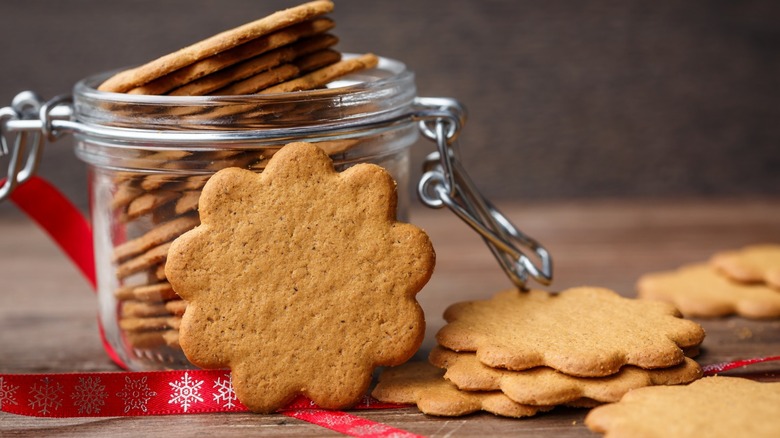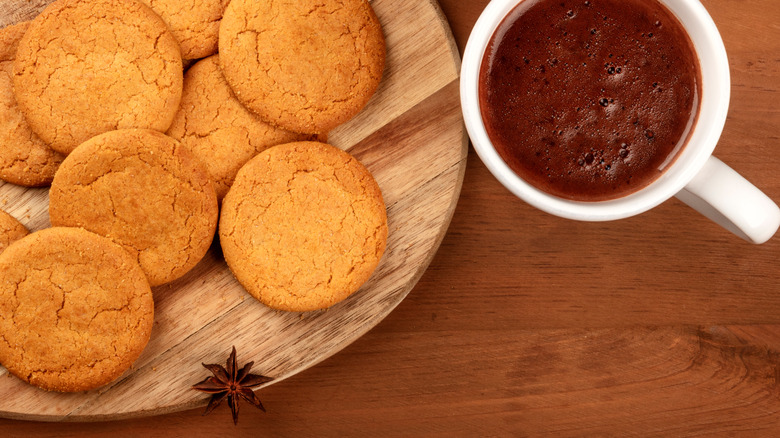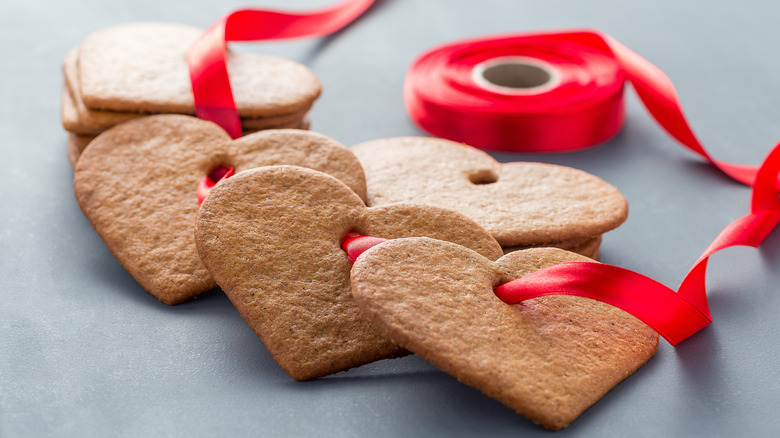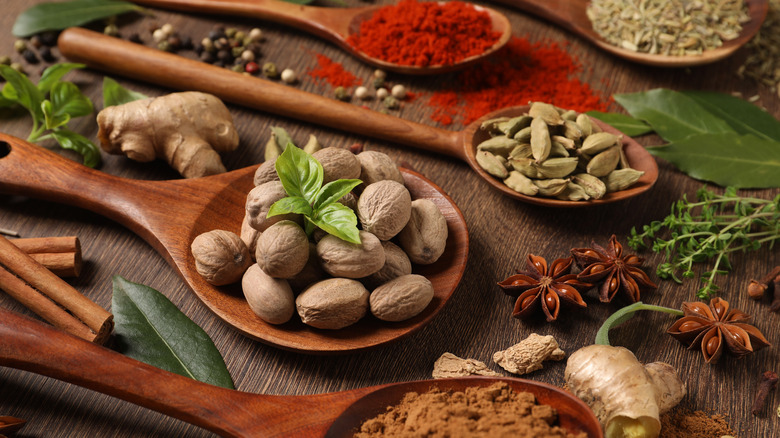Meet Pepparkakor, Sweden's Take On Ginger Cookies
Swedes really know how to do the holidays. You would have a hard time going to any Swedish home during the month of December without seeing a platter of pepparkakor, which are essentially thin, spicy ginger cookies. Pepparkakor are made from rolled-out, chilled dough that is then cut into various shapes, much like American gingerbread. Hearts, stars, and animals are particularly popular shapes. In some cases, they're decorated. Many prefer them plain to appreciate their spiced flavor fully.
The history of pepparkakor dates back several centuries. Customs hold that pepparkor came to Sweden many centuries ago from Germany, where gingerbread itself began. They've become an icon of Swedish holiday desserts, even getting a shout-out in the classic 1945 Swedish novel "Pippi Longstocking." They are particularly popular during the winter holidays, which include Christmas as well as St. Lucia Day. Swedes enjoy them all year with a nice cup of coffee or as a light, sweet snack.
How to enjoy pepparkakor
Pepparkakor are flavored with a blend of spices, including ginger, cinnamon, and cloves. Unlike some softer gingerbread recipes, pepparkakors are intended to be very thin and crisp. Many enjoy them on their own as a part of the Swedish fika tradition, which is basically an extended afternoon tea break. The cookies taste delicious after you dip them into a cup of coffee or tea. During Christmas festivities, it is typical to serve them with a cup of the Swedish mulled wine glögg.
Pepparkakor can include coverings of frosting or powdered sugar, but it's also common for people to eat them plain. Some recipes call for the addition of almonds or raisins, similar to German-style gingerbread "lebkuchen." Another common pairing that might strike you as odd is pepparkakor and bleu cheese. Evidently, the sharp, peppery spices go well with the funky but creamy flavors of bleu cheese. If you want to pair them with something quintessentially Swedish and aren't quite hardcore enough to slab bleu cheese on top, you can't go wrong with some whipped cream and lingonberries.
You can make pepparkakor at home as long as you have a few basic baking tools. There is no special equipment required, much like American gingerbread. If you're over holiday baking already, you can snag some at Ikea and other Northern European holiday and food stores. Those cookies might go by ginger thins or ginger crisps rather than pepparkakor, though.
Swedish traditions with pepparkakor
You certainly can make pepparkakor at any time of year, but it's especially common during the Christmas season. Just like how America enjoys decorating gingerbread houses around the holiday (which Sweden has its own version of in pepparkakshus), Swedes do the same with pepparkakor. Pepparkakor is often a part of the julbord, which is basically an over-the-top buffet-style snacking plate that includes cheese, cured meats, pickled herring, and smoked salmon. Of course, pepparkakor are among other desserts that Swedes serve for Christmas lunch.
But pepparkakor aren't just for eating. Because they are central to Christmas celebrations, there are some fun cultural rituals associated with them. You'll often see pepparkakor cookies hung from twine over a fireplace or even dangling from a Christmas tree as a homemade ornament. If you're keen to decorate for Christmas with pepparkakor, just use a drinking straw to puncture the dough before baking. That will ensure you can tie a string through it. There's also a fun game to play with pepparkakor. While holding a pepparkakor cookie in one hand, you make a wish, then tap it with your other hand. The prediction is that if the cookie breaks into three pieces, your wish will come true.
Historical variations of pepparkakor
At first, people ate pepparkakor for medicinal purposes. They believed spices like ginger and pepper to have health and digestive benefits. The name "pepparkakor" translates to "pepper cookies" in English and the original recipes did indeed contain black pepper. The inclusion of pepper, along with other spices, would have given the cookies an earthier, more savory taste. The use of spices like pepper in sweet cookies might seem unusual today but it was more common in medieval European confections.
Over time, as culinary preferences evolved and as the availability and popularity of certain spices changed, the prominence of pepper in these recipes may have diminished. Modern pepparkakor recipes often emphasize other spices like ginger, cardamom, cloves, and cinnamon, which still give a spicy, peppery flavor without the actual black pepper. However, some traditional recipes may still include black pepper while others may call for other savory spices like cayenne.
Pepparkakor versus American gingerbread
Pepparkakor are very similar to American-style gingerbread due to their ingredients. Both usually include molasses, sugar, butter, and spices. Gingerbread and pepparkakor aren't identical, though. In texture, pepparkakor are quite thin and crispy. American gingerbread's texture can vary but it is generally a bit softer and chewier because they're on the thicker side. The gingerbread dough for gingerbread houses and people is usually made from a sturdier, firmer dough, more similar to pepparkakor, however.
The two cookies also differ in flavor. American gingerbread goes heavy on the molasses, which makes for a sweet cookie with some lightly smokey, bitter, and tangy flavors. Pepparkakor, on the other hand, use less or sometimes no molasses at all. Instead, pepparkakor bakers opt for the addition of golden syrup, a popular European sugar syrup. With a less-pronounced molasses flavor, pepparkakor's spices stand out for a slightly sharper and pepperier flavor. Because of these differences, pepparkakor are probably more akin to ginger snap cookies despite the fact that they are cut into various shapes with cookie cutters like gingerbread.
Finally, it wouldn't be a truly Swedish take on a recipe if it didn't include a healthy bit of cardamom. Cardamom is wildly popular in Sweden, especially when it comes to desserts like Swedish apple pie or cardamom buns. American gingerbread doesn't usually include this zesty, aromatic spice, and instead relies on cinnamon, nutmeg, cloves, and ginger. Pepparkakor also uses these spices but many recipes will also call for cardamom.




